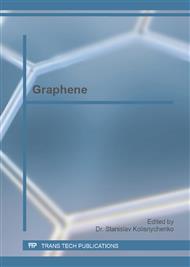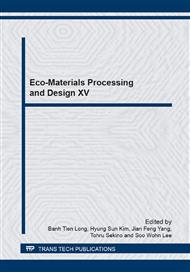p.19
p.23
p.27
p.31
p.35
p.39
p.43
p.47
p.51
Fabrication and Electrochemical Performance of Nitrogen-Doped Graphene Synthesized by Hydrothermal Method
Abstract:
In this study, nitrogen doped graphene (NG) was prepared by using hydrothermal treatment of graphene oxide (GO) and ethylene diamine (EDA). The surface chemistry of the reduced graphene oxide (rGO) and the NG was investigated by the X-ray photoelectron spectroscopy (XPS). The results revealed that there were four kinds of nitrogen substitution: pyrollic N, pyridinic N, graphitic N and C-NH2. Further, the electrical measurements illustrated that the NG had superior capacitive performance than that of the rGO. Specifically, the maximum specific capacitance of NG was 200.6 F/g due to the double-layer capacitive and pseudocapacitive effect from the nitrogen-doped graphene. In addition, the present studies showed that the EDA was not only choose as nitrogen doping source but also played a key role in reduction.
Info:
Periodical:
Pages:
35-38
Citation:
Online since:
October 2014
Price:
Сopyright:
© 2015 Trans Tech Publications Ltd. All Rights Reserved
Share:
Citation:



